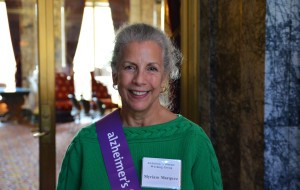Myriam Marquez was driving home from her job as a lawyer six years ago in the Skagit Valley when she realized she didn’t know where she was.
“At that moment, I knew I had Alzheimer’s,” she said.
The warning signs were there. Marquez’ father was one of 13 children — eight of whom developed Alzheimer’s. Her older cousins had been diagnosed before her. Now, her and two of her siblings have been diagnosed with the disease that destroys memory.
“It’s too late for me,” she said. “But not for my children and grandchildren and the thousands and thousands of other people who will be diagnosed.”
Marquez is one of 107,000 Washingtonians suffering from Alzheimer’s. She was also among hundreds of advocates who came to the state Capitol on Friday to watch the governor unveil the state’s first plan to address Alzheimer’s and other dementias.
The plan is three years in the making. Gov. Jay Inslee convened an Aging Summit in 2013, where participants identified the need for a plan.
The following year, the Legislature approved a bill authorizing the plan and creating the Alzheimer’s Disease and Dementia Working Group to develop it.
Goals of the 168-page plan released Friday include:
- Raising public awareness about Alzheimer’s and dementia
- Improving care and safety for patients
- Promoting early identification and treatment
- Increasing support and safety of caregivers
- Enhancing long-term service and support
- Improving research on Alzheimer’s and other dementia diseases
Gov. Inslee told the crowd Friday about his personal experience with his father’s Alzheimer’s.
“I saw the anxiety associated with his disease, I saw the constant need for his wife to help him. I saw something I was very proud of, which is my sons helping him through those difficult days,” he said.
“These families need help. These families need an Alzheimer’s plan by the state of Washington,” Inslee said.
The number of Washingtonians with Alzheimer’s will more than double by 2040, according to the plan. They’re currently being cared for by an estimated 324,000 caregivers, largely unpaid family members.
Marquez, who now lives in Seattle, sits on the Washington Alzheimer’s Association board and is a member of the work group created by Inslee.
She said Alzheimer’s doesn’t just impact patients and their families.
“As baby-boomers age, if a cure is not found Alzheimer’s will destroy the economy,” she said.
According to the Alzheimer’s Association, it is the most expensive disease — even more expensive than heart disease or cancer — with an estimated cost of more than $225 billion in the United States. That figure is expected to grow to $530 billion by 2040.
It’s also the third leading cause of death in Washington state when adjusted for age, according to the state plan.
Randi Chapman, Director of State Affairs for the Alzheimer’s Association, said that people will see “real change” as the state plan is implemented.
“You’re going to see family caregivers better able to access dementia-capable supports and services. You’re going to see improvements in your health system’s ability to identify dementia, to deal with dementia early,” she said.
Chapman said the state can also expect to see better Alzheimer’s research and information.
“I’m filled with a lot of emotions,” Marquez said after the unveiling. “This is my fifth year here, and to see the number of people who show up — it’s just amazing.”
